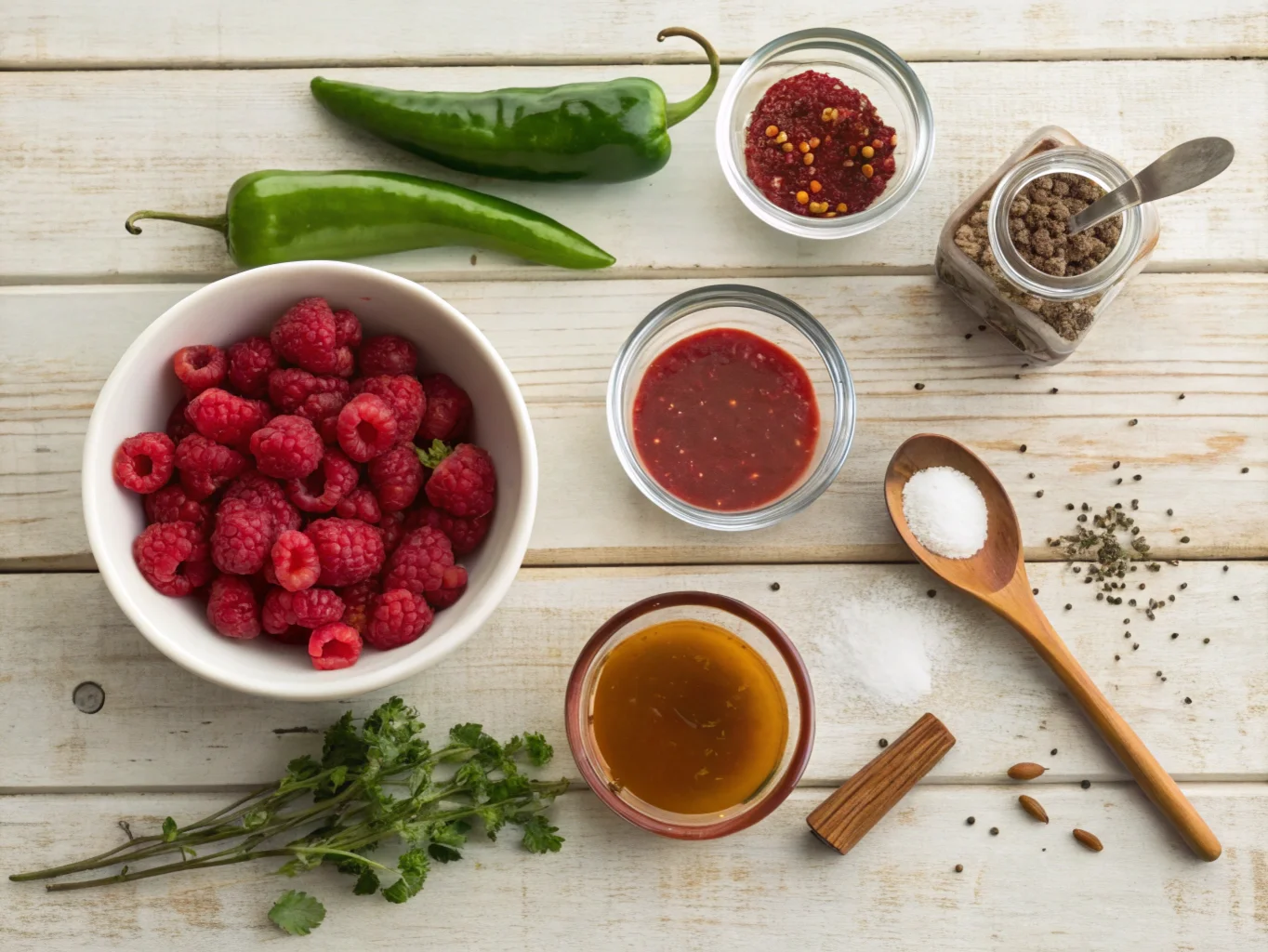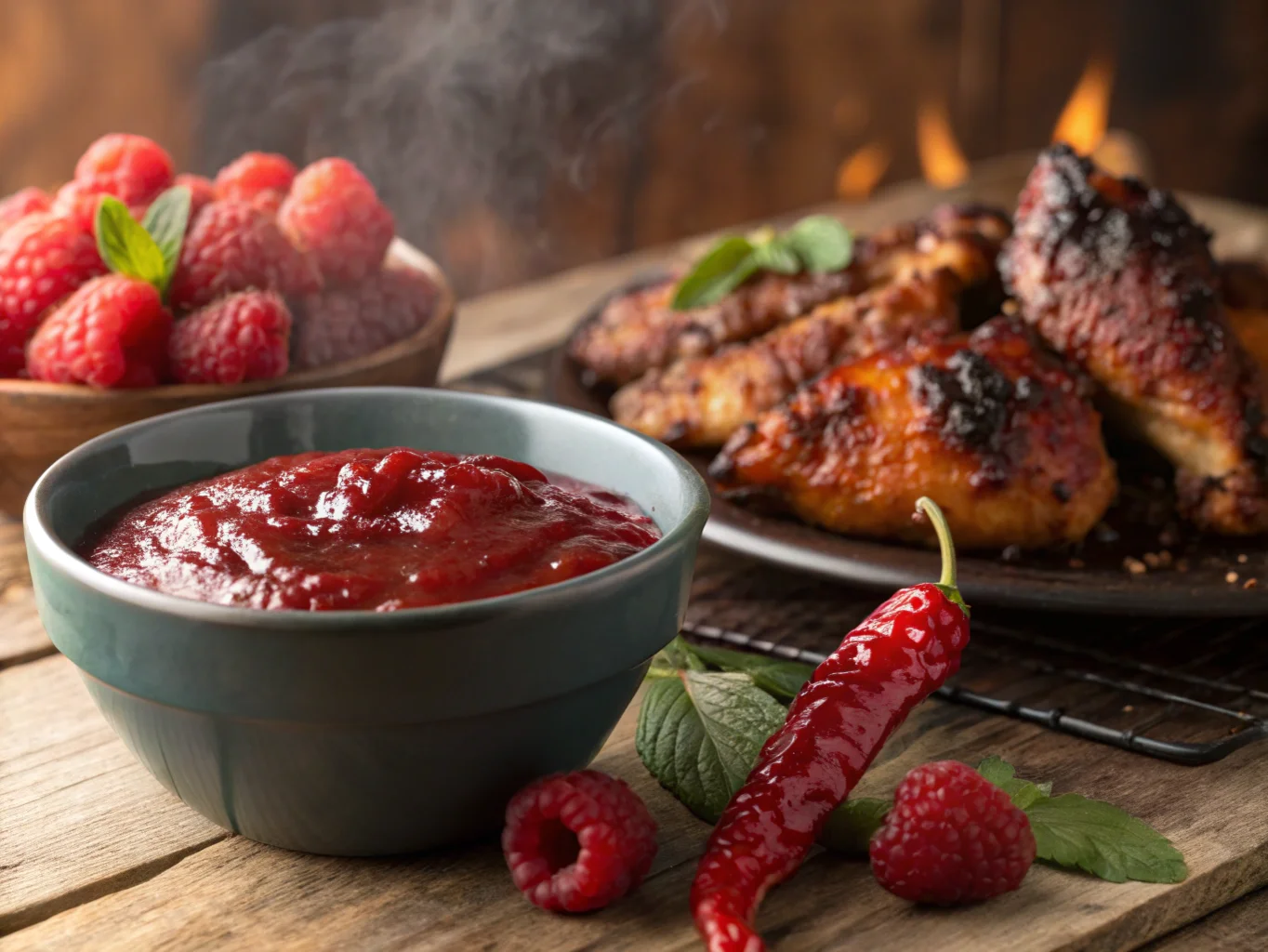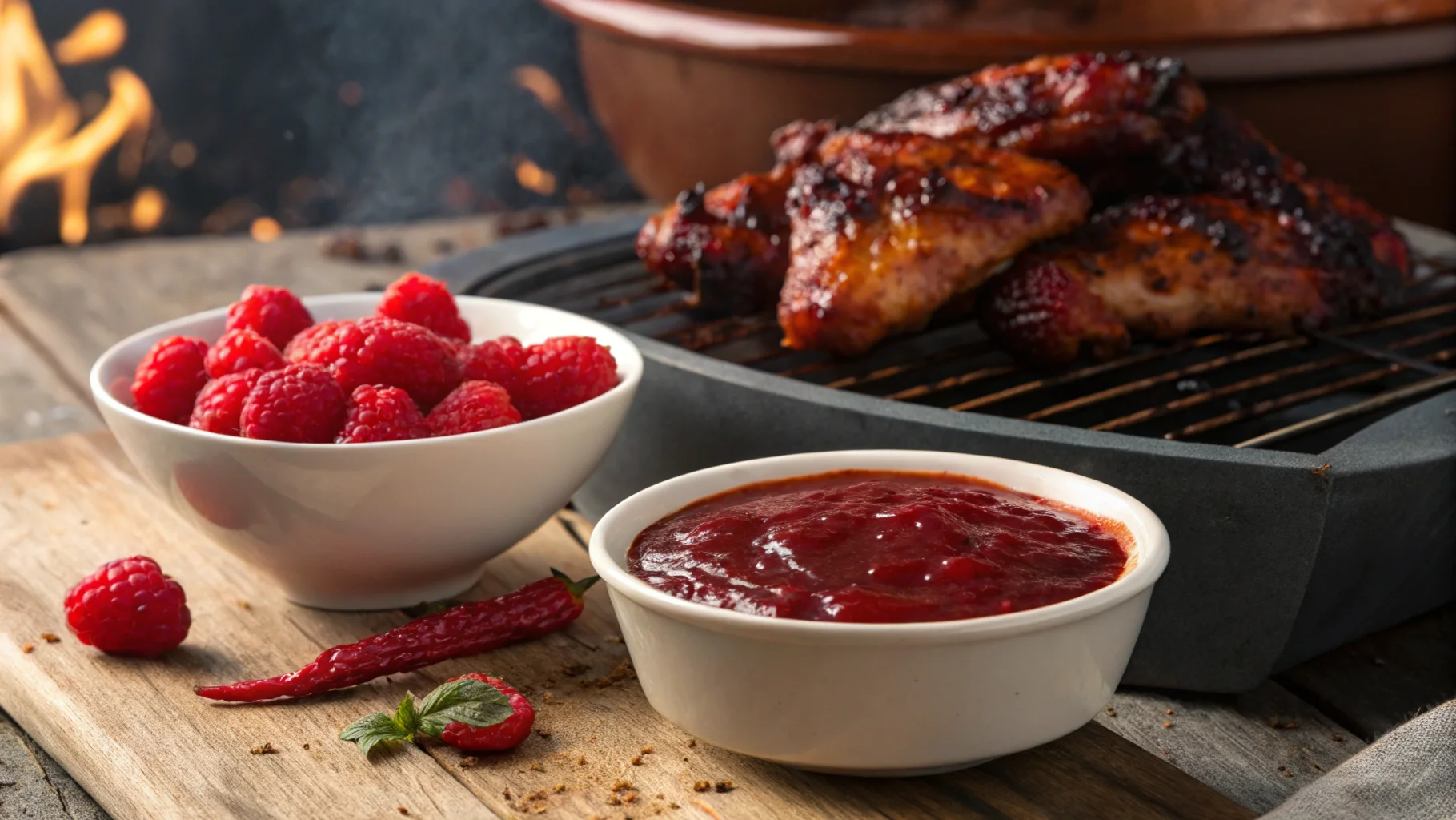Introduction: The Sweet & Smoky Secret to Unforgettable BBQ
Picture this: sunshine filtering through backyard trees, laughter floating on summer air, and the tantalizing aroma of meat sizzling on the grill. Now imagine elevating that entire experience with a homemade sauce so remarkable, guests will talk about your cookout for years to come.
I still remember standing in my neighbor’s backyard, utterly speechless after tasting what appeared to be an ordinary pulled pork sandwich. That first bite revealed an extraordinary flavor profile – sweet berries dancing with smoky heat in perfect harmony. When pressed for his secret, he smiled and whispered, “raspberry chipotle sauce.”
- Bist Amazon Picks:
After countless kitchen experiments, endless taste tests, and some spectacular failures, I’ve finally recreated that magical moment with a recipe worth sharing. This raspberry chipotle sauce strikes the perfect equilibrium between sweet, tangy berries and smoky, spicy chipotle heat – a combination guaranteed to transform your BBQ from mundane to magnificent in five straightforward steps.
Read on to discover how this extraordinary concoction might become your signature grilling companion and the secret weapon behind your future backyard gatherings.
Why This Raspberry Chipotle Sauce Will Transform Your BBQ Experience
Standard BBQ sauces crowd supermarket shelves – thick, brown, and predictable. They satisfy basic expectations but rarely inspire genuine excitement. Enter raspberry chipotle sauce – a remarkable deviation from convention that awakens taste buds and creates memorable dining experiences.
The magic lies in contrasting elements working in harmonious balance. Sweet, bright raspberries deliver natural sweetness without artificial overtones. Meanwhile, smoky chipotle peppers contribute moderate heat alongside distinctive smokiness derived from their traditional drying process. When these flavor powerhouses merge, something extraordinary happens – a sauce possessing depth, character, and distinctive personality.
Beyond flavor complexity, this sauce demonstrates remarkable versatility. Brush it on chicken thighs during final grilling minutes, use as a glaze for salmon, slather on ribs, or drizzle over smoked brisket. Even grilled vegetables benefit from this flavor enhancer, transforming everyday produce into conversation-worthy sides.
Sarah M., an early recipe tester, remarked, “Every cookout sauce I’ve tried eventually becomes background noise – pleasant but forgettable. This raspberry chipotle creation actively makes food better, highlighting natural flavors while adding something completely unexpected. I’ve started bringing jars as hostess gifts because nobody expects sauce to taste this remarkable.”
Fruit-forward BBQ sauces have historical precedent across numerous culinary traditions. From peach-based sauces in Georgia to guava-enhanced varieties in Caribbean cuisine, combining fruit with heat delivers time-tested results. Modern grillers increasingly embrace these combinations, appreciating their ability to complement smokiness while cutting through fatty richness inherent in barbecued meats.
Ready to revolutionize your grilling repertoire? Let’s gather ingredients.
What You’ll Need: Simple Ingredients for Amazing Flavor
Essential Ingredients for the Best Raspberry Chipotle Sauce

| Ingredient | Quantity | Notes |
|---|---|---|
| Fresh raspberries | 2 cups | Provides sweet-tart foundation; frozen acceptable when thawed and drained |
| Chipotle peppers in adobo sauce | 2-3 peppers + 2 tbsp sauce | Delivers controlled heat and essential smokiness |
| Brown sugar | 1/2 cup | Enhances caramelization and depth |
| Apple cider vinegar | 1/4 cup | Balances sweetness with necessary acidity |
| Garlic cloves | 4 cloves, minced | Contributes savory undertones |
| Onion | 1/2 medium, finely diced | Sweet varieties preferred for complementary flavor |
| Tomato paste | 2 tablespoons | Adds richness and body |
| Worcestershire sauce | 1 tablespoon | Provides umami complexity |
| Salt and black pepper | To taste | Balances and enhances overall flavor profile |
| Olive oil | 2 tablespoons | For initial sautéing |
Kitchen Tools You’ll Need
Your kitchen likely contains everything required for successful sauce creation:
- Blender or food processor (essential for smooth consistency)
- Medium saucepan (heavy-bottomed preferred)
- Wooden spoon (allows frequent stirring without scratching cookware)
- Fine mesh strainer (optional for ultra-smooth results)
- Glass jar for storage (allows visibility and prevents absorbing flavors)
5 Easy Steps to Make the Best Raspberry Chipotle Sauce for BBQ
Step 1: Prepare Your Berries and Aromatics

Begin by thoroughly rinsing raspberries, removing any stems or debris. Allow berries to drain completely in colander while preparing remaining ingredients. Excess moisture dilutes flavor and extends cooking time unnecessarily.
Next, finely chop onion into uniform pieces approximately 1/4-inch square. Consistency matters – irregular chunks create uneven flavor distribution. Mince garlic cloves finely, avoiding pressed garlic which often imparts bitter notes.
For chipotle pepper preparation, remove peppers from adobo sauce, reserving sauce separately. Slice peppers lengthwise and scrape seeds with knife edge. Save seeds separately – they provide concentrated heat without significant flavor alteration and can be added gradually for heat customization.
Experienced cooks recognize chipotle peppers vary dramatically in heat level. Start conservatively – you can always increase spice intensity, but taming excessive heat proves challenging. When working with peppers, consider wearing disposable gloves to prevent oils from contacting sensitive skin.
Step 2: Create the Flavor Base
Heat olive oil in medium saucepan over medium heat until shimmering but not smoking. Add chopped onions with pinch of salt, stirring occasionally until translucent – approximately five minutes. Patience during this step develops foundational sweetness as natural sugars release and caramelize slightly.
Once onions reach proper transparency, add minced garlic, stirring continuously for thirty seconds until fragrant. Critical timing point: garlic burns quickly, turning bitter and potentially ruining entire sauce. Maintain vigilant attention during this brief cooking window, reducing heat if necessary.
This aromatic foundation creates depth impossible to achieve through simple ingredient combining. Properly sautéed aromatics release essential oils and develop complex flavor compounds that elevate finished sauce beyond ordinary condiment status.
Step 3: Combine and Simmer
Add raspberries, prepared chipotle peppers, reserved adobo sauce, brown sugar, vinegar, tomato paste, Worcestershire sauce, and black pepper. Stir thoroughly to incorporate everything into cohesive mixture.
Bring combination to gentle simmer – bubbling should appear restrained rather than vigorous. Reduce heat to maintain gentle cooking environment and prevent scorching.
Allow mixture to simmer 15-20 minutes, stirring occasionally to prevent bottom sticking. During this crucial phase, berries break down, releasing vibrant color and natural pectin while flavors meld and intensify. Extended simmering develops remarkable complexity impossible in quick-cook versions.
As mixture simmers, extraordinary transformation occurs: individual ingredients surrender distinct identities, creating unified, harmonious flavor profile with previously unimagined complexity. Sauce gradually thickens as moisture evaporates and natural pectins activate.
Throughout simmering process, taste occasionally (using clean spoon each time) to monitor flavor development. Make mental notes regarding balance and complexity, but avoid premature adjustments – final seasoning occurs after blending.
Step 4: Blend to Perfect Consistency
Remove saucepan from heat and allow mixture to cool slightly – approximately 10-15 minutes. Attempting to blend excessively hot liquids creates dangerous pressure within blender, potentially causing injury and certainly creating unnecessary cleanup.
Transfer mixture to blender or food processor. Begin pulsing gradually, monitoring consistency changes with each pulse. For chunky, rustic sauce, limit blending to few quick pulses. For silky presentation-worthy consistency, blend continuously until completely smooth.
For ultimate refinement, strain blended sauce through fine-mesh strainer, pressing with spatula to extract maximum liquid while leaving seeds and remaining solids behind. This extra step creates restaurant-quality presentation while maintaining full flavor integrity.
Return blended sauce to saucepan for final adjustments. Now evaluate seasoning – add salt gradually, tasting between additions until balanced flavor emerges. Acidity balance proves equally important; additional vinegar brightens while small brown sugar additions enhance depth.
Step 5: Rest and Store
Simmer finished sauce additional five minutes after blending. This final cooking integrates adjusted seasonings while concentrating flavors through slight reduction.
Allow sauce to cool completely before transferring to storage container. During cooling, flavors continue developing through passive chemical reactions. Professional chefs understand patience during this phase yields significant quality improvements.
Transfer cooled sauce to clean glass jar with tight-fitting lid. While plastic containers work, glass prevents staining and flavor absorption. Label with date for proper rotation.
While tempting to use immediately, allow sauce minimum 24-hour refrigeration period. During this resting phase, flavor compounds continue melding, resulting in noticeably improved taste profile. This waiting period represents crucial difference between good and exceptional sauce.
How to Use Your Homemade Raspberry Chipotle BBQ Sauce
Perfect Pairings for Your Raspberry Chipotle Sauce
This versatile sauce enhancement partners brilliantly with numerous proteins and preparations:
Grilled Chicken: Apply during final 5-7 minutes of cooking, allowing heat to concentrate flavors without burning natural sugars. Bone-in thighs particularly benefit from this pairing, as sauce penetrates while maintaining moisture.
Pork Ribs: Brush sauce lightly during final 30 minutes of cooking, applying 2-3 thin layers rather than single thick coating. This layering technique creates flavor depth without excessive charring.
Beef Brisket: Serve sauce alongside rather than during cooking. This approach preserves traditional smoke ring and bark while allowing diners to customize flavor intensity.
Grilled Vegetables: Brush lightly on vegetables like zucchini, eggplant, and bell peppers during final grilling minutes. The sauce’s sweetness caramelizes beautifully on vegetable surfaces.
Dipping Applications: Serve slightly warmed in small ramekins alongside chicken tenders, grilled shrimp, or crusty bread. Room temperature works perfectly for sandwich enhancement.
Application Methods for Maximum Flavor
Timing significantly impacts flavor development. Apply sauce too early and sugars burn; too late and flavors remain superficial. For ideal integration, apply during final quarter of cooking time – this allows proper adhesion and caramelization without carbonization.
Consider layering technique: rather than single heavy application, brush multiple thin layers, allowing each to set briefly before adding next. This method creates remarkable depth while maintaining food integrity.
Temperature control proves equally important. Most BBQ sauces perform best between 225-275°F – hot enough for proper rendering but cool enough to prevent sugar burning. When cooking at higher temperatures, delay sauce application accordingly.
Variations to Try: Customizing Your Raspberry Chipotle Sauce
Heat Level Adjustments
Mild Version: Reduce chipotle peppers to one, substitute remaining pepper quantity with roasted red bell pepper. This maintains volume and texture while significantly reducing heat intensity.
Extra Spicy: Incorporate fresh habanero or serrano pepper alongside original chipotle quantity. Alternatively, add 1/4 teaspoon cayenne powder during final cooking stage for controlled heat increase.
Balanced Heat: For most crowd-pleasing variation, use exactly 2 medium chipotle peppers with 1.5 tablespoons adobo sauce – this provides noticeable warmth without overwhelming delicate raspberry notes.
Sweetness Modifications
Honey Substitution: Replace half brown sugar quantity with local honey for floral notes and enhanced stickiness – particularly beneficial for glazing applications.
Savory Direction: Reduce sugar by 25% while increasing Worcestershire sauce to 1.5 tablespoons. This adjustment emphasizes umami characteristics while maintaining essential sweetness.
Berry Complexity: Substitute 1/2 cup raspberries with blackberries or blueberries. This simple adjustment introduces remarkable complexity through varied fruit acid profiles and anthocyanin compounds.
Texture Options
Ultra-Smooth: After standard blending, pass sauce through fine mesh strainer twice, pressing thoroughly between strainings. This restaurant technique creates silky, elegant presentation.
Chunky Style: Pulse mixture minimally, maintaining distinct berry pieces. This rustic approach provides textural interest and visual appeal.
Seedless Version: Strain raspberries before cooking, using only pressed juice. This technique sacrifices some pectin benefits but creates exceptionally refined sauce suitable for elegant presentations.
Storage Tips and Shelf Life
Proper Storage Methods
Refrigeration: Properly cooled sauce stored in airtight container maintains optimal quality up to two weeks. Always use clean utensils when portioning to prevent contamination.
Freezing: For extended preservation, portion sauce into ice cube trays, freeze solid, then transfer cubes to freezer bags. This method preserves quality up to three months while providing convenient portion control.
Canning Option: For shelf-stable preservation, process in water bath canner following standard acidic food protocols. Properly processed jars remain shelf-stable up to one year when stored in cool, dark location.
Watch for separation, off odors, or unusual coloration – these indicate spoilage requiring immediate disposal. Natural separation occurs during storage; simply stir before using.
Make-Ahead Options for Entertaining
Prepare sauce 2-3 days before event for peak flavor development without storage concerns. Production batches up to triple original quantities maintain proper consistency; beyond this, prepare multiple standard batches.
When reheating for service, warm gently over medium-low heat, stirring frequently to prevent scorching. Add tablespoon water if needed to restore original consistency.
Why This Recipe Works: The Science Behind the Flavor
The extraordinary appeal of raspberry chipotle sauce stems from strategic chemical synergy. Capsaicin compounds in chipotle peppers stimulate taste receptors differently than sweet raspberry compounds, creating fascinating sensory contrast. Meanwhile, natural fruit acids work enzymatically, breaking down meat proteins for enhanced tenderness.
During cooking application, sauce’s natural sugars undergo Maillard reaction, creating hundreds of new flavor compounds impossible in uncooked versions. This caramelization process enhances complexity while improving visual appeal through attractive glazing.
Different meats benefit from specific sauce components: beef responds to sauce’s acidic elements, pork harmonizes with sweetness, while poultry highlights chipotle’s smoky characteristics. This versatility explains why properly made raspberry chipotle sauce enhances virtually anything from grill.
Conclusion: Elevate Your BBQ Game with Homemade Raspberry Chipotle Sauce
Exceptional barbecue transcends technique alone – it requires perfect flavor enhancement. This raspberry chipotle sauce delivers precisely that balance: bright fruit sweetness, complex smokiness, moderate heat, and proper consistency for versatile application.
Unlike commercial alternatives laden with preservatives and artificial ingredients, your homemade version showcases real food excellence. Guests will notice the difference immediately, even if they can’t identify specific reasons for improvement.
Consider preparing extra batches for gifting – few homemade presents receive warmer welcome than extraordinarily delicious sauce. Mason jars with simple labels transform this recipe into memorable gesture for fellow food enthusiasts.
We’d love hearing about your experiences with this recipe. Which variation became your favorite? Which protein pairing worked best? Share your results and modifications in comments below – your discoveries might inspire fellow cooking enthusiasts to explore new flavor directions!
Now, gather those ingredients, set aside creative kitchen time, and prepare to revolutionize your barbecue reputation – one delicious, raspberry-tinged bite at a time.
Frequently Asked Questions About Raspberry Chipotle Sauce for BBQ
Can I make this Best Raspberry Chipotle Sauce recipe for BBQ ahead of time?
Absolutely! The flavors in this raspberry chipotle sauce actually improve substantially after 24-48 hours of refrigeration. Chemical reactions continue during cold storage, allowing individual flavor compounds to meld into more harmonious profile. Many experienced cooks deliberately make this sauce 2-3 days before important gatherings, recognizing that patience delivers superior results. When preparing ahead, store in glass containers rather than plastic to prevent flavor absorption and potential staining.
How long does homemade raspberry chipotle BBQ sauce last?
When properly stored in airtight container in refrigerator, your homemade best raspberry chipotle sauce recipe for BBQ maintains optimal quality approximately two weeks. Watch for natural separation (easily remedied by stirring) versus actual spoilage indicators like off odors, unusual coloration, or mold. For extended storage, freeze in convenient portions using ice cube trays initially, then transfer frozen cubes to freezer bags for up to three months. Always label with production date to ensure proper rotation.
Is there a way to make this raspberry chipotle sauce less spicy?
Definitely! To create milder version of this best raspberry chipotle sauce recipe for BBQ, reduce chipotle peppers to single pepper and decrease adobo sauce to one tablespoon. Additionally, carefully remove all seeds and membranes from pepper before incorporating, as these contain highest capsaicin concentration. For extremely mild preference, substitute half the chipotle quantity with roasted red bell pepper, maintaining volume while significantly reducing heat. Remember you can always increase spiciness gradually by adding reserved seeds or additional adobo sauce during final cooking phase.
Can I use frozen raspberries instead of fresh in this BBQ sauce recipe?
Yes! Frozen raspberries work exceptionally well in this best raspberry chipotle sauce recipe for BBQ, particularly when fresh berries prove expensive or unavailable. Simply thaw completely before using and drain excess liquid to prevent diluting flavor concentration. Many experienced cooks actually prefer frozen berries for consistent ripeness and convenience. When using frozen berries, extend cooking time slightly to evaporate additional moisture. The flavor profile remains virtually identical to fresh-berry versions while offering significant cost savings during off-season periods.
What meats pair best with raspberry chipotle BBQ sauce?
This best raspberry chipotle sauce recipe for BBQ demonstrates remarkable versatility across protein spectrum. Pork presents perfect partnership – particularly ribs, tenderloin, and shoulder cuts where sauce enhances natural sweetness. Chicken benefits tremendously, especially thighs and wings where sauce creates glorious lacquered exterior while penetrating meat. Beef brisket receives beautiful flavor enhancement, particularly when sauce is offered alongside rather than during smoking. Even lamb and certain fish varieties (particularly salmon) respond beautifully to this sauce’s balanced flavor profile. For unexpected application, try brushing on halloumi cheese before grilling for vegetarian-friendly option.
Can I can this raspberry chipotle sauce for longer storage?
Yes! This best raspberry chipotle sauce recipe for BBQ contains sufficient acid content for safe water bath canning preservation. Process thoroughly cleaned half-pint jars for 15 minutes (adjusting for altitude if necessary) following standard canning protocols. Properly processed jars remain shelf-stable up to one year when stored in cool, dark environment. This preservation method proves particularly valuable for gift-giving or preserving seasonal berry harvests. Always verify proper seal before storage and refrigerate after opening, using within two weeks for optimal quality.
How can I adjust this recipe if I don’t have chipotle peppers in adobo sauce?
If chipotle peppers in adobo remain unavailable, create reasonable substitute for this best raspberry chipotle sauce recipe for BBQ using 1-2 teaspoons ground chipotle powder (adjust according to heat preference), 1 tablespoon tomato paste, and 1/4 teaspoon liquid smoke. This combination approximates distinctive smoky-spicy chipotle character while maintaining proper sauce consistency. Alternatively, rehydrate dried chipotle peppers in hot water for 20 minutes, then process with small amount of tomato paste to create homemade adobo equivalent. While flavor profile varies slightly from original, these adaptations deliver remarkably similar results suitable for authentic barbecue experiences.

